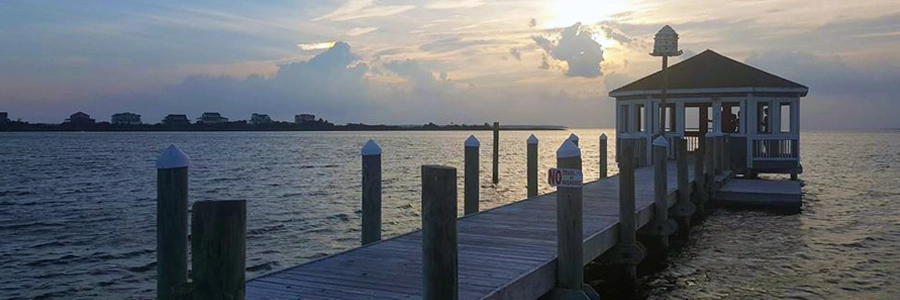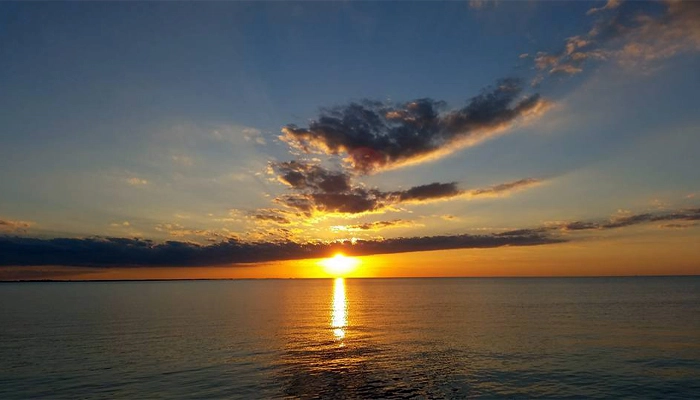We know that the main reason most people head to the beach is to be near the ocean. Luckily for beach goers, the Outer Banks offers miles of pristine beaches and plenty of unobstructed views. However, if you’ve never been to the Outer Banks, you may be surprised to find that we are surrounded by water on both sides! Since the Outer Banks is a string of barrier islands, we have two ways for you to experience North Carolina’s coastal waters – the Ocean Side to the East and the Sound Side to the West. If you want to learn more about the “other side” of the beach, we’ve prepared some helpful information so that you can experience the sound side of the Outer Banks for yourself.
Understanding the Outer Banks Sound Side
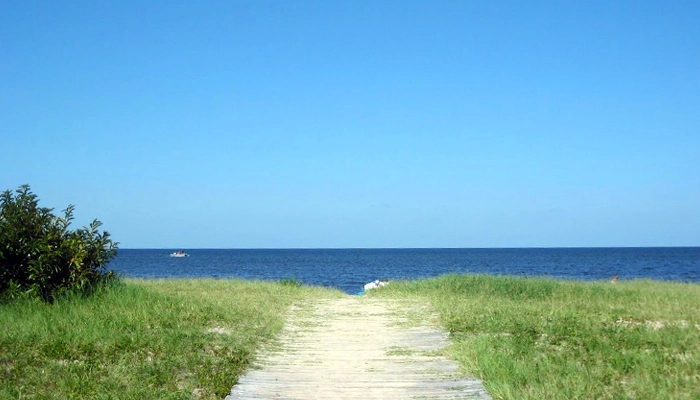
The “sound” is the name for the water system between mainland North Carolina and the Outer Banks barrier islands. The term “sound side” specifically refers to the west side of the Outer Banks whose shoreline borders the sound from the northernmost parts of Corolla all the way south to Ocracoke Island. The Outer Banks sound side is just one large continuous stretch of water, the waterway is broken up geographically into 5 distinct sounds - the Currituck Sound, the Albemarle Sound, the Croatan Sound, the Roanoke Sound, and the Pamlico Sound (click on the sound name to view location on Google Maps).
Find out more about each of these locations below!
This system of sounds is actually a natural estuary – the place where freshwater streams and rivers meet the open ocean. According to National Geographic, there are 4 types of natural estuaries: coastal plain estuaries (like the Chesapeake Bay), tectonic estuaries (like San Francisco Bay), fjord estuaries (like the Puget Sound), and bar-built estuaries (like the Outer Banks sounds). The sound itself is protected from ocean waves, coastal winds and bad weather systems by a series of barrier islands and sandbars (hence the name “bar-built). The Outer Banks sounds are part of the Albemarle - Pamlico National Estuary system, the second largest estuary in the contiguous states.
Currituck Sound
The Currituck Sound is the body of water between mainland Currituck and the northern portion of the island containing Southern Shores, Duck, Corolla, and the Currituck National Wildlife Refuge. Connecting to the Albemarle Sound west of Kitty Hawk, the Currituck Sound is comprised of wide-open waterways and is surrounded by acres of naturally sustained maritime forests and marshland. These conditions draw in ample wildlife making it a popular location for visitors to explore by kayak. To see the Currituck Sound for yourself, stop by the Historic Currituck Park where you can have a picnic by the water and launch your kayak or visit Duck Town Park where a mile-long boardwalk along the sound offers beautiful up-close views.
Albemarle Sound
The Albemarle Sound is a huge body of water encompassing the area West of the Outer Banks and stretches inland to mainland North Carolina. In fact, it is one of the largest estuaries in North Carolina and is the connecting point for dozens of major waterways including rivers that travel up to Virginia. Due to its wide span, The Albemarle Sound once served as a major transportation and trade route for both Natives and European colonists. By the 1800s, the sound was surrounded by major ports that expanded into a massive commercial fishing industry. Unfortunately, overfishing saw that industry cease and today, most of the towns along the sound are small maritime communities where visitors flock for the nature trails, bird watching, recreational fishing, and boating. There are several public accesses in Kitty Hawk and Kill Devil Hills where visitors to the Outer Banks can experience the Albemarle Sound for themselves. A soundfront rental is a great idea for any traveler who wants to explore the sound with a kayak or paddleboard.
Croatan Sound
Between the town of Manns Harbor on Mainland North Carolina and towns of Wanchese and Manteo on Roanoke Island sits the third body of water known as the Croatan Sound. The Croatan Sound was once mostly swamp and marshland until the former Roanoke Inlet shifted throughout the 1700s causing water to shift into the soft marshland. Today, the Croatan Sound is one of the deepest in the area with low salinity levels due to the freshwater rivers that feed its waters. Generally underdeveloped, it is also an excellent place for visitors to spot migratory birds and other local wildlife species. To see the Croatan Sound for yourself, consider making a loop on U.S. Hwy. 64 which crosses the William B. Umstead Memorial Bridge, the newer Virginia Dare Memorial Bridge, and winds through the historic towns of Manteo and Manns Harbor.
Roanoke Sound
The Roanoke Sound is located on the East side of Roanoke Island and borders the West side of South Nags Head and parts of the Cape Hatteras National Seashore. The Roanoke Sound runs up to 7-miles wide in some places while as little as 3-miles wide in others. Connecting to both the Albemarle Sound to the North and the Pamlico Sound to the South, this body of water is where early European settlers first positioned their settlements. While it is still a haven for local wildlife, it is also a popular spot for boating or recreational and commercial fishing due to its many boat docks. Outer Banks visitors exploring Historic Downtown Manteo can enjoy a gorgeous walk along the water as they visit the Roanoke Marshes Lighthouse and enjoy lunch from one of the many delicious downtown restaurants.
Pamlico Sound
The Pamlico Sound is located to the west of Hatteras Island and Ocracoke Island sitting to the east of Mainland Dare and Hyde counties. At around 80-miles long and up to 20-miles wide, it is the largest sound along the entire Eastern seaboard. In fact, some early explorers even mistook the Pamlico Sound for the Pacific Ocean. Fed by the Oregon Inlet, Hatteras Inlet and Ocracoke Inlet, it connects to both the Atlantic Ocean and the northern sounds which keeps it at a moderate mix of fresh and saltwater. Despite its size, it is very shallow in comparison to the other sounds in the area which has caused treacherous navigation and soundside flooding throughout the last few centuries, particularly during stormy conditions. However, the Pamlico Sound is derived from a unique ecosystem of fish, mammals, waterfowl, and reptiles while also boasting wildlife preserves, saltwater marshes, and maritime forests. Visitors can access the Pamlico Sound from any number of private and public sound beaches (including the Salvo Day Use Area and the Canadian Hole between Avon & Buxton) to look for wildlife, cast out a line, or spend the day swimming in the shallow waters without worrying about dangerous ocean currents. Water sports enthusiasts especially flock to the Pamlico Sound due to the ideal conditions for paddleboarding, parasailing, windsurfing, kiteboarding, and kayaking. Plus, no matter where you stand along the Pamlico Sound, you are guaranteed a view of an unparalleled sunset.
Why Choose the Sound Side for Your Outer Banks Beach Vacation?
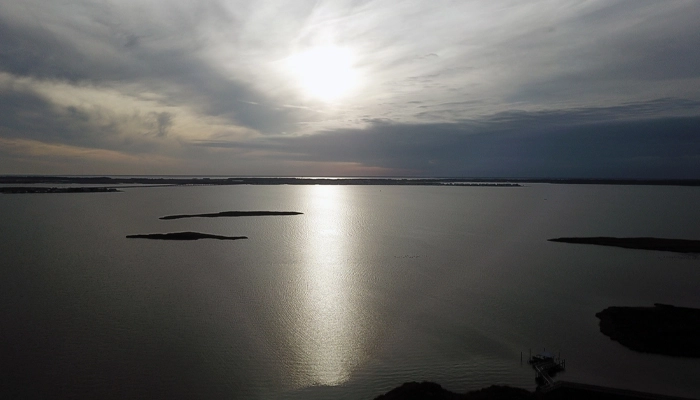
Considering a stay on the sound side? In addition to our numerous oceanside vacation rentals, Seaside Vacations also features many beautiful soundside homes. Depending on what your ideal beach vacation looks like and who you are traveling with, the sound side may actually offer more benefits to you than the ocean side and it's often more affordable! Of course, the biggest advantage that a soundside home has over an oceanside home is the view of THE INCREDIBLE OUTER BANKS SUNSET. When you stay in the Outer Banks of North Carolina oceanside will get you the best sunrises, but the soundside sunsets simply can't be beat.
Ideal for Kids
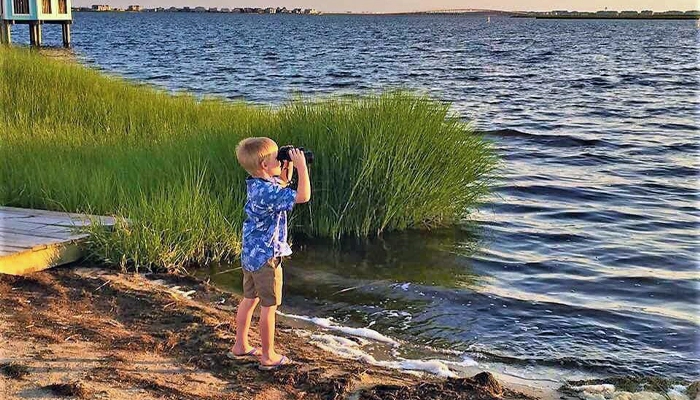
The water of the sound is generally much calmer and more predictable than the ocean. The sound appears more like a giant lake with its vast space, shallow waters, and small, gentle waves. This makes the sound an ideal place to go if you have kids who love being out in the water! Although bad weather or strong currents can create some choppy water conditions in the sound, swimmers in the ocean must be wary of potential threats at all times such as strong undertow, rough waves, and rip currents. Even breaking waves on the beach can be dangerous for young children who are too close to the water's edge but most sound beaches allow for a smooth, gradual entry into the water so kids (and adults) can easily just walk out. Although the water is not deep enough in most places for adults to swim, kids will have a blast!
Short Drive to the Ocean
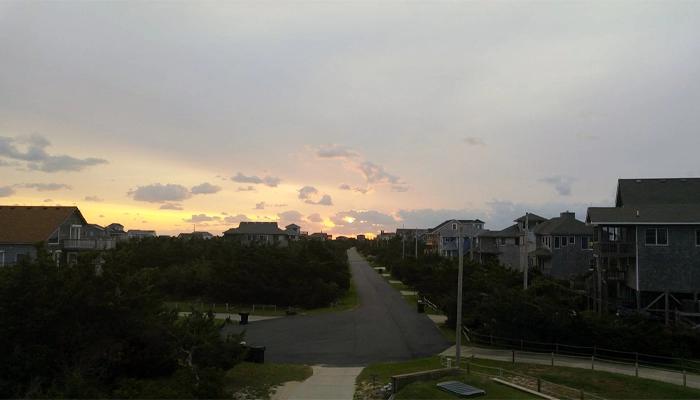
Staying on the sound side doesn’t mean you can’t visit the ocean any time you want! The Outer Banks is a series of islands after all, and these islands aren't particularly wide. In the northern beaches of Duck and Corolla or in the southern beaches of Hatteras Island, it’s quite easy to walk from the sound side to an ocean side beach access. On wider parts of the beach, it may not be feasible to walk but at just a couple miles wide, it takes no time at all to drive from your vacation rental to a public beach access. Even when you stay in the far western soundside community of Colington Island, the beach is just a 15-minute drive away. There are even some rental homes that enjoy the luxury of ocean views and sound views right from their deck due to being in a narrower part of the Outer Banks!
Cost Efficient
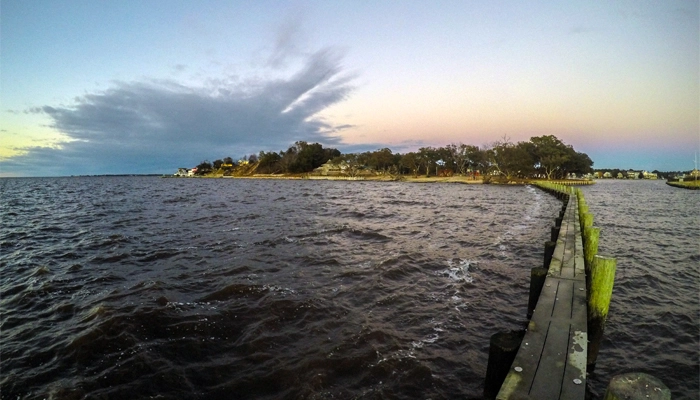
Staying on the sound side will typically get you more bang for your buck! Since the ocean side is usually in higher demand, prices for ocean side homes are often much higher. If you are looking to get a larger house with more amenities (like a private pool or home theater), consider searching for houses on the sound side. As we mentioned, getting to the ocean is a breeze but being on the sound offers plenty of benefits on its own. Keep in mind that you pay for location so a soundfront home is going to cost more than a soundside home (which may or may not have a view depending on the location). If you aren’t sure about the proximity to the sound for a particular home, just ask one of our guest services representatives for clarification.
What To Do On The Sound
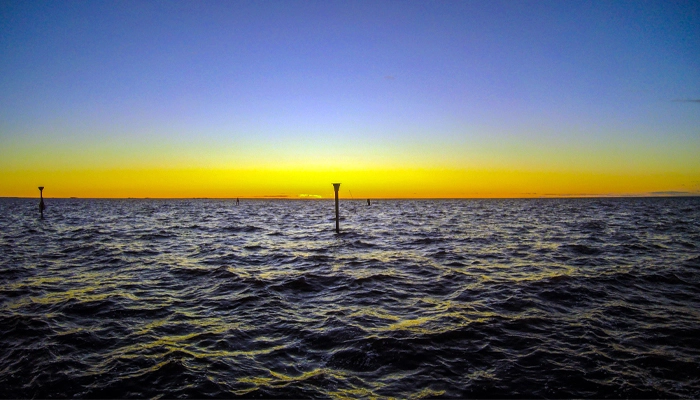
Since many people are unfamiliar with the sound, it isn't uncommon for visitors to leave sound-based activities off their to-do list. However, from watching sunsets and crabbing to kayaking and stand-up paddleboarding, the sound side is the perfect place for fun vacation activities that will make your trip memorable!
Watching Sunsets
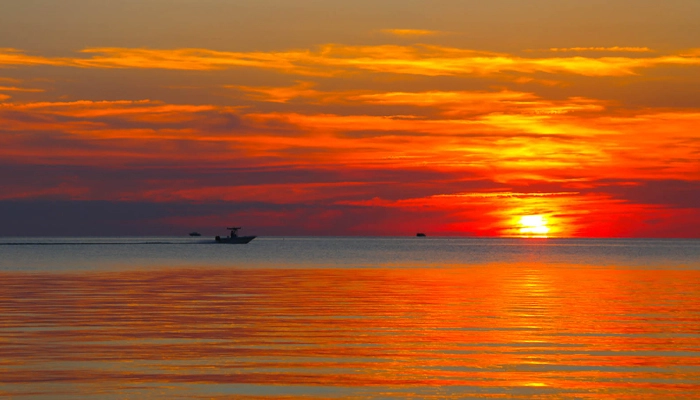
Watching the sunset is one of the best activities to do on the sound. While you can’t deny the beauty of a sunrise over the ocean, for those of you who aren’t early birds, the sunset may be more your style. And if you’ve never seen a sunset over the sound, you’re missing out. Thanks to the fact that we are surrounded by water, we get the unique benefit of waterfront sunrises and waterfront sunsets which is something most beach destinations can’t claim. Check the local forecast for the time of sunset and head out to one of the many public sound accesses to witness something truly magical. Pictures can’t do it justice and words can’t even describe the beauty. For the ultimate sunset experience, book a soundfront vacation rental and your world will become a watercolor portrait every single evening.
Fishing/Crabbing
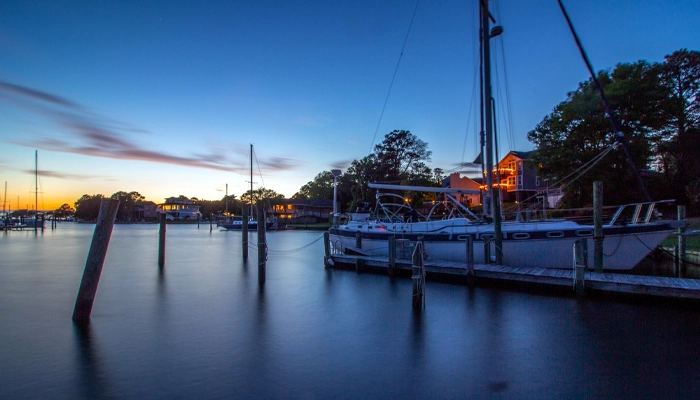
Who said fishing was just for the ocean? Fishing and crabbing are extremely popular activities on the Outer Banks and the sound is often the location of choice! From gamefish and bottom dwellers to mollusks and crustaceans, the sound is plentiful with saltwater species that are fun to catch and great to eat! There are public accesses with docks for fishing and crabbing while some vacation rentals even feature private docks for guests to use. Thanks to the sounds’ shallow waters and lack of breaking waves, it’s also easy to wade out to deeper spots to try your luck. Launching a kayak or other personal watercraft is also a popular option and there are even charter boats that stay exclusively in sound waters so your options are limitless! Guests with Seaside Vacations are eligible to receive various discounts on inshore sound charters and crabbing excursions with Club Seaside through OBX Pontoon Man, Rock Solid Fishing Charters and Wanchese Marina Fishing Charters!
Note: Keep in mind that North Carolina requires anglers to possess a temporary or annual Coastal Fishing License which you can purchase online or at a local tackle shop. Some parts of the sound, (the Currituck Sound in particular) are considered “Inland” waters instead of “Coastal” waters and may require an Inland or joint Inland/Coastal license. Charters have blanket licenses for all anglers on board. Click here for a detailed map of inland vs coastal water boundaries. Regarding fishing regulations, check NC Marine Fisheries for the latest fishing size and bag limits.
Water Sports
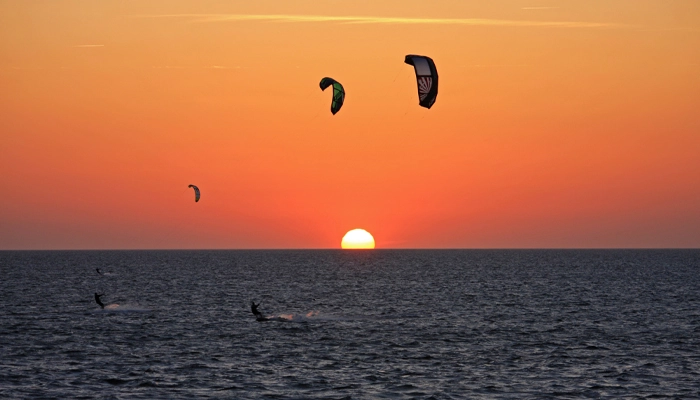
Every year, the ideal conditions of the sound waters draw in thousands of water sports enthusiasts from all over the world! From kayaking, jet skiing, and stand-up paddleboarding to kiteboarding, wakeboarding, and windsurfing, the sound is a hot spot for all sorts of popular watersports. If you already know what you’re doing, just hit the water and enjoy! If you don’t own your equipment, there are plenty of places that offer rentals and as a bonus, Seaside Vacations guests are eligible to receive a discount on watersport equipment rentals from Kitty Hawk Kites through Club Seaside! Are you a beginner? No problem! The shallow, calm water is the perfect place to try something new. Consider taking a lesson from a professional at a local company or joining a group workshop to learn the ropes. With so many different watersports to choose from, the sound literally offers hours of fun.
Accessing The Sound
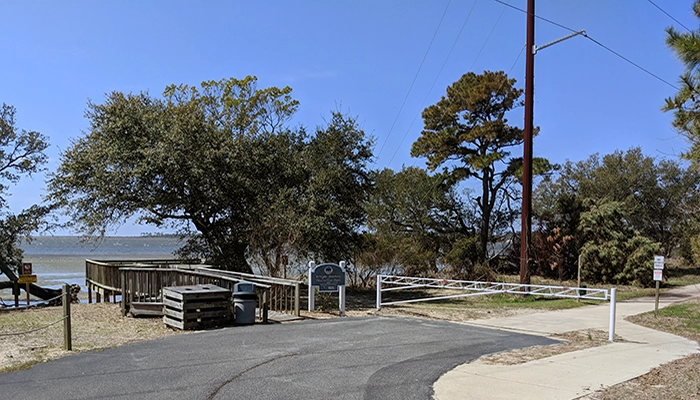
There are public sound accesses in almost all towns along the Outer Banks. Some accesses are particularly good for swimming and feature a large beach area to camp up for the day. Some are well equipped for launching watercraft. Others feature docks or gazebos ideal for photographs. A few of the best sound accesses include Historic Corolla Park in Corolla, Duck Town Park in Duck, Windgrass Circle Park in Kitty Hawk, Dock Street, Second Bridge on Colington Road, and Nags Head Woods in Kill Devil Hills, Jockey’s Ridge State Park Soundside Road, Melvin R. Daniels Bridge, and Oregon Inlet Fishing Center in Nags head, Washington Baum Bridge in Manteo, and the Salvo Day Use Area and Haulover/Canadian Hole on Hatteras Island.
Keep in mind that this is not a complete list of all the public sound accesses. There are also private sound accesses in various communities as well as several public soundfront restaurants, marinas, shopping centers and attractions (like Manteo Waterfront) that provide exceptional views and access to the water. For easy access and the best view possible, book a soundfront or soundside vacation rental!
Soundside FAQs
Is the Sound salt water?
Yes! The sound is an estuary, or in other words, a body of brackish water where fresh water from rivers combines with salt water from the ocean. Although more diluted by the freshwater than the ocean in some parts, sound water is still salt water.
Is it windy on the Sound?
Yes! It may not be the same strength as an ocean breeze but there is still a breeze on the west side of the islands which averages between 9-10 mph according to the APNEP (Albemarle-Pamlico National Estuary Partnership). However, the winds on the Outer Banks change quickly and could be slower or much faster, even on the sound side.
How deep is the Sound?
In general, the sound is quite shallow. There are some channels that reach a depth of up to 26 feet, but the average depth ranges from around 5 to 15 feet depending on the area. Most of the sound along the shore is only waist deep. For additional details on size and depth of the sound in different areas, please visit the NOAA Nautical Chart Catalog.
What fish and shellfish live in the Sound?
Although you never know what you might catch in the sound, some species in particular call the shallow, marshy waters home. Flounder, Redfish, Rockfish/Striped Bass/Stripers, Speckled Trout, King and Spanish Mackerel, Tarpon, Mullet, Pompano, Blue Crab, Oysters, Clams, and Shrimp are just some of the common species you might find.
Are there sharks in the Sound?
This is one of the most frequently asked questions on Google and it’s understandable. Most people share a confusing mix of awed respect, general fear and total fascination when it comes to sharks. Plus, with companies like Ocearch, it’s easier than ever to track huge sharks all across the world and in January 2015, a well-known 2,300-pound 14-foot great white named Katherine pinged right here in the Pamlico Sound and spent about 18 hours swimming the sound waters. The sound connects to the ocean through a series of inlets so yes, any marine animal found in the ocean could be found in the sound including sharks, crabs, jellyfish, skates, fish, sting rays, and dolphins, with many marine animals residing in the shallow brackish water. While you should always be aware of your surroundings, ocean rip currents are much more dangerous than ocean marine life and despite what you might see in movies, shark attacks are very rare.
Can you swim in the Sound?
Yes and no.* While it is safe to get in the sound water, adults may find it difficult to swim since the water is shallow (knee to waist deep) in most locations. There are parts of the sound that have deeper channels but these are typically frequented by boats. It isn’t uncommon to be able to walk pretty far out into the water before it starts getting deeper. However, if you just want to splash around, wade into the water to cool off, float, or let the kids play, the shallow sound water is perfect!
*Keep in mind that during particularly warm summers or after storms, water quality advisories may sometimes be put in place due to bacteria in the water. Check the NC Environmental Quality website for up-to-date information and be sure to read all signs and warnings posted.
Are there bacteria in the Sound?
Generally, the sound is safe for humans. However, at times, floodwaters and stormwater runoff may cause pollutants and other bacteria to enter the water. If this happens, Currituck County and Dare County will issue advisories if, at any point, the average bacteria level in the water exceeds state and/or federal standards making it unsafe to swim. Pollution runoff is not exclusive to sound waters... these advisories can be issued for the ocean too.
*Check the NC Environmental Quality website for up-to-date information and be sure to read all signs and warnings posted.

About the Author: Jessie has been coming to the Outer Banks since she was just 5 years old. She loved it here so much that she finally relocated in 2018. Now her mission is to show the world that the Outer Banks is an incredible place that everyone should experience. When she isn't working, you can find Jessie hanging out with her friends, chilling at home with a good book, or discovering a new Outer Banks adventure.

